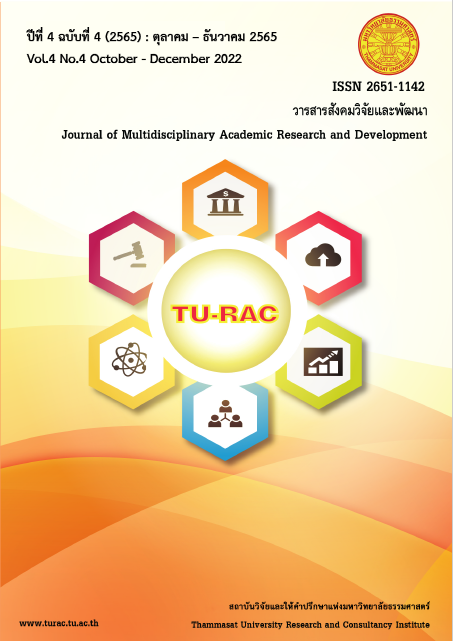Employment Insurance Benefits: Development, Contributions, and Possibilities in the Thailand Social Context
Keywords:
Employment insurance, Social Security fund, Skill development benefit, Unemployment compensationAbstract
The labour market in Thailand is being challenged, culminating in risks for laborers, including employment insecurity and unemployment. This research studied means of developing employment insurance benefits for sustainable employment development to expand extant unemployment benefits to cover employment insurance and provide recommendations for stipulating sources, contribution payment formats, and other relevant details. Methodologies included documentary research; a survey of 2,032 insured and 232 operating samples; in-depth interviews with representatives from 10 public and private sector organizations; and a focus group of 115 participants comprising insured and employer representatives. Results were that Thailand should extend coverage for insured workers, instead of focusing solely on employment benefits through contributory payments for the unemployed and incomeless to developing capacity limits for finding employment and developing related skills. Sources of funding should include equally proportioned contributions from the insured, employers, and the government. Contributions from insured workers should be flexible and based on affordability, with a set minimum contribution; by contrast, proportionate input from employers and the government should be equivalent. Employment benefits should cover four areas: compensation benefits for unemployment, skill development, recruitment, and tax benefits.
References
กรมการจัดหางาน. (2563). สถิติคนต่างด้าวที่ได้รับอนุญาตทำงานคงเหลือทั่วราชอาณาจักร ประจำเดือน ธันวาคม 2563. สืบค้นเมื่อวันที่ 20 กุมภาพันธ์ 2565, จาก https://www.doe.go.th/prd/assets/upload/files/alien_th/a0bf3232bdb42f5fe6dbe66cfa75b02c.pdf.
ปาจรีย์ วายโสกา. (2553). ปัญหาการว่างงาน. สืบค้นเมื่อวันที่ 22 กุมภาพันธ์ 2565, จาก http://pachari-ploymob.blogspot.com/2010/01/blog-post.html.
สัมฤทธิ์ ศรีธำรงค์สวัสดิ์. (2543). การปฏิรูประบบสุขภาพ: กรณีศึกษาประเทศญี่ปุ่น. สถาบันวิจัยระบบสาธารณสุข.
สุนันทา เสียงไทย. (2557). การเปลี่ยนแปลงในระบบการจ้างงานในประเทศญี่ปุ่น. วารสารญี่ปุ่นศึกษาธรรมศาสตร์. 31(1), 41-54.
สำนักงานสถิติแห่งชาติ. (2563). สรุปผลการสำรวจภาวะการทำงานของประชากร. สืบค้นเมื่อวันที่ 20 กุมภาพันธ์ 2565, จาก https://www.nso.go.th/sites/2014/Pages/สำรวจ/ด้านสังคม/แรงงาน/ภาวะการทำงานของประชากร.
เสาวลักษณ์ หีบแก้ว (2560). แรงงาน Freeters ในสังคมญี่ปุ่น: สถานการณ์ ปัญหาและมาตรการภาครัฐ.วารสารวิชาการเฉลิมกาญจนา. 4(2), 300-316.
องค์การยูนิเซฟ. (2563). การประเมินผลกระทบรวมด้านเศรษฐกิจและสังคมจากการแพร่ระบาดของโรคโควิด-19 ในประเทศไทย. สืบค้นเมื่อวันที่ 20 กุมภาพันธ์ 2565, จาก https://www.unicef.org/thailand/media/5671/file/Socio-.
อาภาพร ผลมี, พัฒน์ พัฒนรังสรรค์, และ ศรีอร สมบูรณ์ทรัพย์. (2561). ปัจจัยที่ส่งผลต่อการจ้างงานแรงงานไร้ทักษะในยุคประเทศไทย 4.0 ของสถานประกอบการในนิคมอุตสาหกรรมแหลมฉบัง จังหวัดชลบุรี. วารสารเศรษฐศาสตร์และนโยบายสาธารณะ. 9(18), 35-48.
พระราชบัญญัติประกันสังคม. (11 สิงหาคม 2533). ราชกิจจานุเบกษา. เล่ม 107 ตอนที่ 161.
สำนักงานประกันสังคม. (2563). สถิติงานประกันสังคม 2563. กลุ่มงานสถิติและคณิตศาสตร์ประกันภัย กองวิจัยและพัฒนา สำนักงานประกันสังคม.
Carter, J., Bedard, M., & Bista, P.C. (2013). Comparative review of unemploymentand employment insurance experiences in Asia and worldwide. Retrieved February 20, 2022, from https://www.ilo.org/asia/publications/WCMS_229985/lang--en/index.htm.
Dek Soon Hwang. (2013). Unemployment Insurance in Asia. SeoUI: Korea Labor Institute.
ILO. (2017). Unemployment protection: A good practices guide and training package experiences from ASEAN. Bangkok: ILO.
Jasos. (2001). Chapter 6 Employment Insurance. Retrieved February 22, 2022, from http://www.ipss.go.jp/s-info/e/Jasos2001/p44-47.html.
Makarenko, J. (2009). Employment Insurance in Canada: History, Structure and Issues. Retrieved February 22, 2022, from https://www.mapleleafweb.com/features/employment-insurance-canada-history-structure-and-issues.html.
Masayoshi, H. (2010). Social Protection in Japan: Current state and Challenges. Retrieved February 22, 2022, from https://www.eria.org/uploads/media/Research-Project-Report/RPR_FY2009_9_Chapter_2.pdf.
Downloads
Published
How to Cite
Issue
Section
License
Copyright (c) 2022 อัครนัย ขวัญอยู่, สรัญญา เตรัตน์, วิชาญ กิตติรัตนพันธ์, ธีระ สินเดชารักษ์

This work is licensed under a Creative Commons Attribution-NonCommercial-NoDerivatives 4.0 International License.



